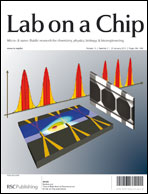Droplet-on-a-wristband: Chip-to-chip digital microfluidic interfaces between replaceable and flexible electrowetting modules†
Abstract
We present a long (204 mm), curved (curvature of 0.04 mm−1), and closed droplet pathway in “droplet-on-a-wristband” (DOW) with the designed digital microfluidic modular interfaces for electric signal and droplet connections based on the study of electrowetting-on-dielectric (EWOD) in inclined and curved devices. Instead of using sealed and leakage-proof pipes to transmit liquid and pumping pressure, the demonstrated modular interface for electrowetting-driven digital microfluidics provides simply electric and fluidic connections between two adjacent parallel-plate modules which are easy-to-attach/detach, showing the advantages of using droplets for microfluidic connections between modules. With the previously reported digital-to-channel interfaces (Abdelgawad et al., Lab Chip, 2009, 9, 1046–1051), the chip-to-chip interface presented here would be further applied to continuous microfluidics. Droplet pumping across a single top plate gap and through a modular interface with two gaps between overlapping plates are investigated. To ensure the droplet transportation in the DOW, we actuate droplets against gravity in an inclined or curved device fabricated on flexible PET substrates prepared by a special razor blade cutter and low temperature processes. Pumping a 2.5 μl droplet at a speed above 105 mm s−1 is achieved by sequentially switching the entire 136 driving electrodes (1.5 mm × 1.5 mm) along the four flexible modules of the DOW fabricated by 4-inch wafer facilities.


 Please wait while we load your content...
Please wait while we load your content...